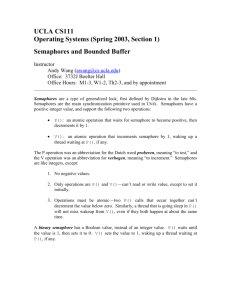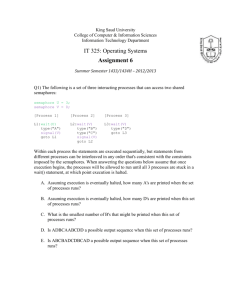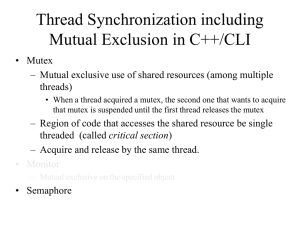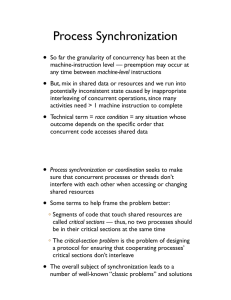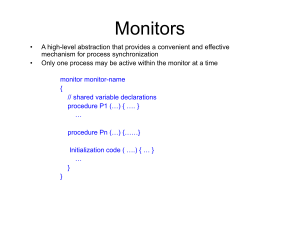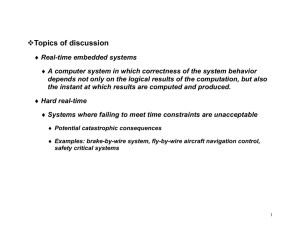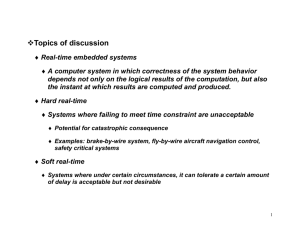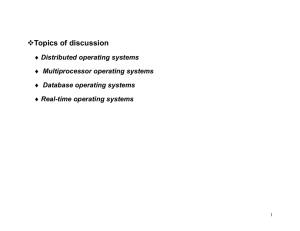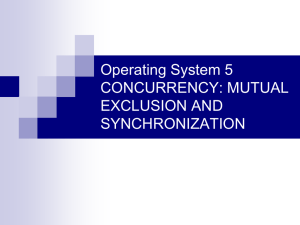Lecture Note VI
advertisement
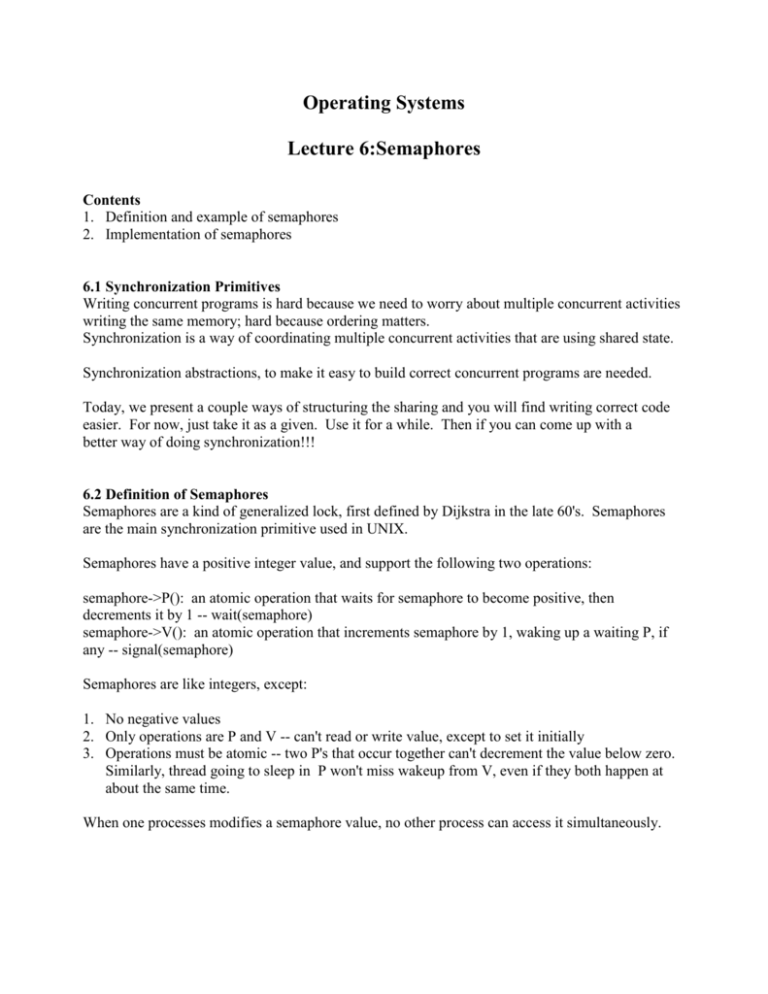
Operating Systems Lecture 6:Semaphores Contents 1. Definition and example of semaphores 2. Implementation of semaphores 6.1 Synchronization Primitives Writing concurrent programs is hard because we need to worry about multiple concurrent activities writing the same memory; hard because ordering matters. Synchronization is a way of coordinating multiple concurrent activities that are using shared state. Synchronization abstractions, to make it easy to build correct concurrent programs are needed. Today, we present a couple ways of structuring the sharing and you will find writing correct code easier. For now, just take it as a given. Use it for a while. Then if you can come up with a better way of doing synchronization!!! 6.2 Definition of Semaphores Semaphores are a kind of generalized lock, first defined by Dijkstra in the late 60's. Semaphores are the main synchronization primitive used in UNIX. Semaphores have a positive integer value, and support the following two operations: semaphore->P(): an atomic operation that waits for semaphore to become positive, then decrements it by 1 -- wait(semaphore) semaphore->V(): an atomic operation that increments semaphore by 1, waking up a waiting P, if any -- signal(semaphore) Semaphores are like integers, except: 1. No negative values 2. Only operations are P and V -- can't read or write value, except to set it initially 3. Operations must be atomic -- two P's that occur together can't decrement the value below zero. Similarly, thread going to sleep in P won't miss wakeup from V, even if they both happen at about the same time. When one processes modifies a semaphore value, no other process can access it simultaneously. 6.3 Implementation of Semaphores Busy Waiting: S.P() S.V() while ( S<= 0) do nothing; done atomically S = S - 1; S = S + 1; Non Busy Waiting: Instead of busy waiting , P() and V() processes can block themselves. Remember last lecture: lock implementation semaphore is a kind of lock. Binary semaphore: instead of an integer value, has a boolean value. P waits until value is 1, then sets it to 0. V sets value to 1, waking up a waiting P if any. 6.3 Two uses of semaphores 6.3.1 Mutual exclusion When semaphores are used for mutual exclusion, the semaphore has an initial value of 1, and P() is called before the critical section, and V() is called after the critical section. Semaphore mutex=1; //declaration mutex.P(); // critical section goes here mutex.V(); and initialization of semaphore mutex. 6.3.2 Scheduling constraints Semaphores can also be used to express generalized sheduling constraints -- in other words, semaphores provide a way for a thread to wait for something. Usually, in this case, the initial value of the semaphore is 0, but not always! For example, you can implement Thread::Join using semaphores: Initial value of semaphore = 0 Thread::Join calls P Thread::finish calls V Semaphores can be used as a synchronization primitive: Semaphore Synch = 0; Process 1 Process 2 . . Statement 1; synch.V(); synch.P(); statement 2; Guarantees that statement 2 will be executed after statement 1. 6.4 Producer-consumer with a bounded buffer 6.4.1 Problem definition Producer puts things into a shared buffer, consumer takes them out. Need synchronization for coordinating producer and consumer. Example: cpp | cc1 | cc2 | as (cpp produces bytes for cc1, which consumes them, and in turn produces bytes for cc2 ...) Don't want producer and consumer to have to operate in lockstep, so put a fixed-size buffer between them; need to synchronize access to this buffer. Producer needs to wait if buffer is full; consumer needs to wait if buffer is empty. Example: Coke machine. Producer is delivery person; consumers are students and faculty. Solution uses semaphores for both mutex and scheduling. Correctness constraints for solution 1) Consumer must wait for producer to fill buffers, if none full (scheduling constraint) 2) Producer must wait for consumer to empty buffers, if all full (scheduling constraint) 3) Only one thread can manipulate buffer queue at a time (mutual exclusion) Use a separate semaphore for each constraint; note semaphores being used in multiple ways. Semaphore fullBuffers; // consumer's constraint : if 0, no coke in machine Semaphore emptyBuffers; // producer's constraint : if 0, nowhere to put more coke Semaphore mutex; // mutual exclusion Semaphore solution Will be done in the class!!!!
